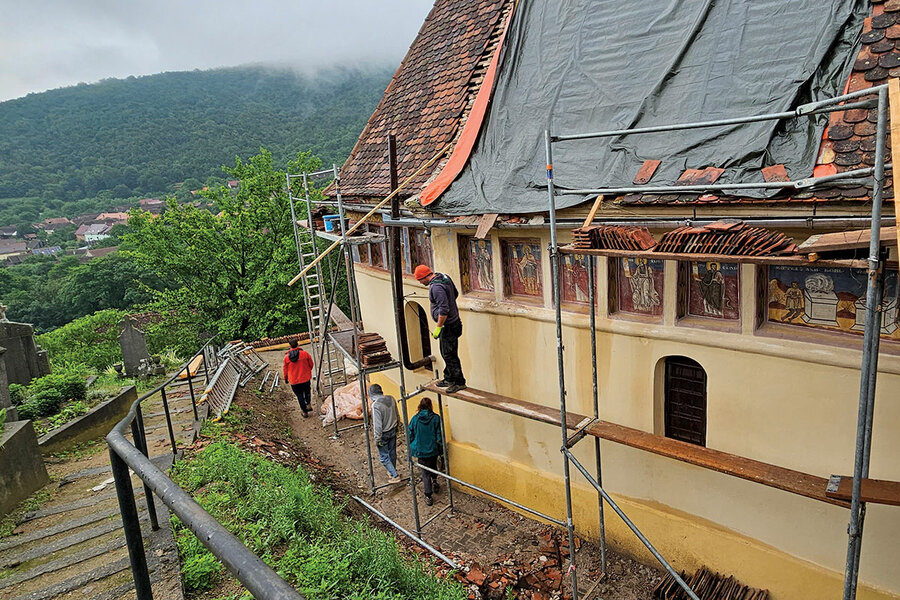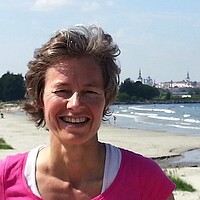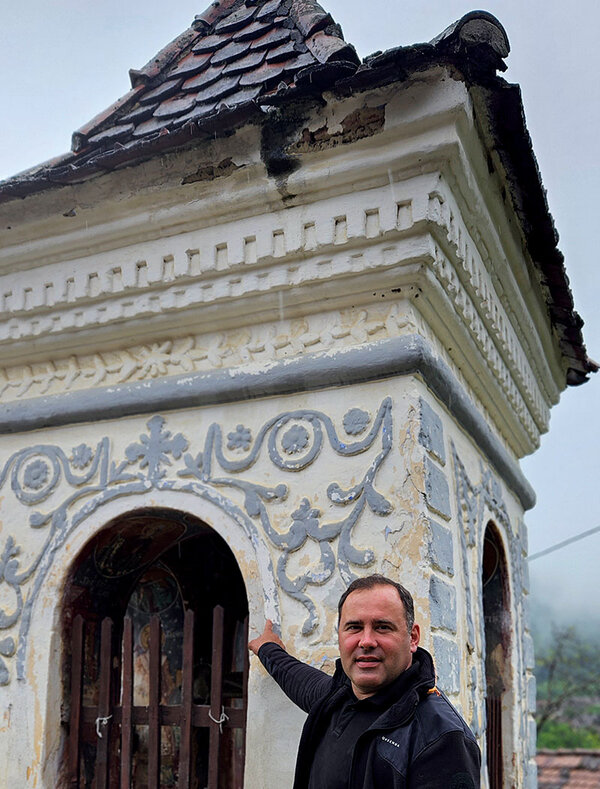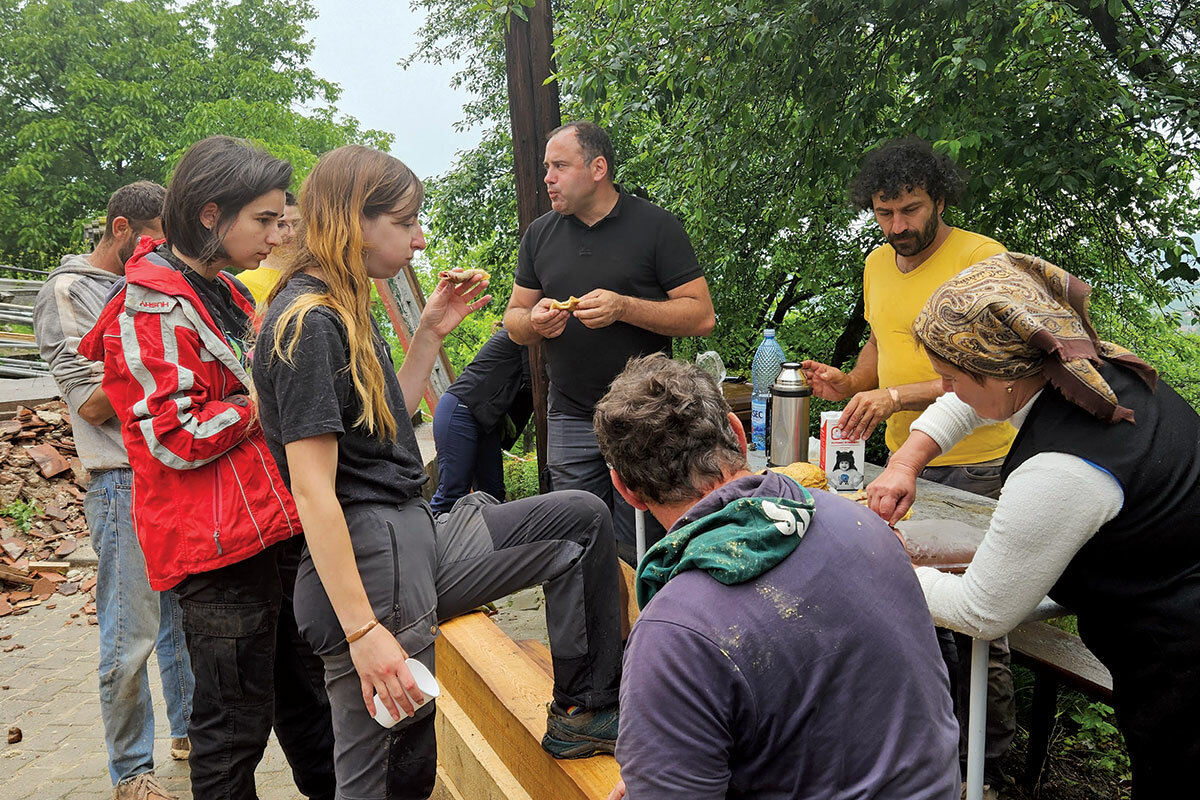With his ‘Ambulance for Monuments,’ a Romanian preserves his culture
Loading...
| Fântânele, ROMANIA
It is midday on a damp Friday. Eugen Vaida guides his team into the final phase of re-tiling the roof of a church, at the crest of a forested hill in this mountainous Transylvanian village.
Village craftspeople and students from the city meticulously lay tiles on the roof timbers of the 18th-century Romanian Orthodox Church of St. Nicholas of the Hierarch. From the scaffolding, students respectfully and attentively watch Nicolae Gabriel Lungu, who is descended from a Romani family who all knew this skill. Soon an older woman summons the crew to share in a platter of clătite, thin cheese-filled crepes.
Once bustling with families and culture, Mr. Vaida’s home region had become a string of largely empty villages surrounding abandoned stone churches. But now, watching this group interact, he has newfound hope. The repair by his group, Ambulance for Monuments, will help safeguard the church’s stunning outer frescoes. And the impact will ripple far beyond the building itself.
Why We Wrote This
A story focused onRomania’s cultural heritage is crumbling. Architect Eugen Vaida is inspiring a grassroots ethos of national pride through historical preservation.
“People are starting to understand the value of heritage,” Mr. Vaida says. For the past seven years, he’s been driving around the country with a van equipped with tools and volunteers in a race against time to rescue endangered historic buildings. He has helped save more than 55 historical structures on the verge of collapse, from medieval churches and fortification walls to old watermills and UNESCO World Heritage Sites. He does so by impressing preservation methods and mindsets onto local communities.
“I wanted to reconnect the members of the community to their roots, make them aware that those buildings are part of their cultural identity, and show them how they can continue the work we do,” he says.
Mr. Vaida offers a “best-practice example of how, with not so much effort, you can save the identity of Romania as a country,” says Ciprian Stefan, director of the ASTRA Museum, Europe’s largest open-air ethnographic museum, in Sibiu.
Architectural heritage in disrepair
Romania’s rich cultural legacy of painted churches and fortified villages was shaped over centuries. But close to 600 historic monuments are in an acute state of degradation, victims of years of dictatorship, poor legislation, and plain neglect, experts say.
Mr. Vaida experienced the destruction in a very personal way. He grew up playing with Romani and Hungarian friends, as well as the German Saxons who had literally built the region. When the 1989 collapse of communist dictatorship flung Romania’s doors wide open, half a million people left. The mass exodus tore the Romanian soul apart – and fractured Mr. Vaida’s own identity. Ambulance for Monuments is an attempt to reclaim both his identity and that of his country.
After his village emptied, he coped by diving into Romania’s traditional customs. He collected artifacts. Traditional dancing rooted him. But he, too, left for the city, to get an education, and he became a successful architect in Bucharest. But six years into the job, he quit to return home. The big city was not his future; his home village was.
He soon discovered that many village craftspeople who had passed on their know-how from generation to generation had left for Western Europe. Those who returned came back imitating what they saw abroad, seemingly unaware that things like PVC window frames and industrial tiles could hurt a building’s health in the long run.
Building “new” and “modern” was in vogue, a matter of prestige. Rather than designing homes for strangers, Mr. Vaida wanted to use his architectural skills to save his region’s extraordinary architectural and cultural heritage. He started by teaching children about local history.
But saving historic buildings required more than awareness. Romania needed architects trained in historical preservation and restoration. So in 2016, he launched Ambulance for Monuments in hopes of connecting architectural students, craftspeople, and communities around a new effort to restore decaying historic buildings.
The program follows “a simple recipe,” he says. Volunteer students get hands-on practice in historical restoration; local craftspeople get jobs; and communities help house and feed the teams, and donate the material. And the three groups learn from one another. “It’s going from grassroots up, from down to up,” says Mr. Vaida.
The program has since grown, recruiting some 800 volunteers annually.
A model by example
Key to Mr. Vaida’s success has been impressing upon locals the importance of preservation efforts with his own generosity and dedication.
“He doesn’t go to villagers to ask for anything, but he goes there to give something,” says Mr. Stefan. “The community stays in the shadows at first. When they see Eugen comes with material and manpower to restore their church, they say, ‘Let’s help him,’ and, little by little, they come and help with housing, with food, and they say, ‘We have a craftsman in the village who knows how to chop the wood,’ for instance.”
Gifted with a deep sense of the Romanian rural environment and an ability to talk to all its actors, from the priest to the villagers, he’s inspired locals to “develop small engines for local development through this heritage,” Mr. Stefan adds.
The task of rescuing Romania’s cultural legacy is huge, but Mr. Vaida sees signs of progress. Partly as a result of his group’s work, the law was changed, making it easier to tackle emergency projects. Some of Romania’s regions devote more money to preserving old monuments. And Mr. Vaida is proud of his project’s popularity among young people, mostly architectural students.
“People are moving back to the villages of their grandparents, because they feel they belong there,” he says. “They are rediscovering old houses, their heritage, their villages, and are getting involved in the preservation of this type of living.”
His work has earned broader recognition as well. In 2020, Mr. Vaida won an award from Europa Nostra, a European heritage protection initiative. That award prompted congratulations from King Charles III of the United Kingdom, who called Mr. Vaida’s work “an inspiration for like-minded people in other countries to follow.”
Confronting mistrust
After a hard day’s work of restoration in Fântânele, Mr. Vaida has invited the entire village to a workshop on jiana, his region’s traditional folk dance. The mayor and two Orthodox priests have come to show their appreciation. The appreciation wasn’t always there. Just after moving to the village during the pandemic, Claudia Maior found local authorities were about to redo the roof of the historical-listed church with industrial tiles. She invited Mr. Vaida to speak to local authorities and villagers about the help his project could offer, but mistrust was deep-seated at first.
“Villagers didn’t understand why the Ambulance didn’t ask for money in return,” she says. In the upheaval of the post-dictatorship years, corruption was rampant, as was mistrust of officials. “People used to give something in order to receive something,” she says.
But eventually the village rallied to the idea and welcomed Mr. Vaida’s team.
“What Eugen is doing is huge awareness-building on how beautiful our heritage is, and how good we can feel if we include what we inherited and not only new things,” says Gabriela Hila, who decided to move to Fântânele during the pandemic. “Eugen is a Romanian from a very Romanian village, and the fact that he is willing to intervene in a Hungarian church or Saxon one is what makes him special.”








